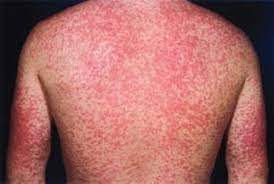Similar findings with EBV and CMV reactivation; causation vs. correlation unclear.
Drug reaction with eosinophilia and systemic symptoms (DRESS) is a rare severe adverse drug reaction involving the skin, liver, kidneys and other organs. It can be fatal. Reactivation of several human herpesviruses has previously been documented in a substantial fraction of patients. Whether this viral reactivation is a cause or a consequence of DRESS, however, remains unclear.
A new retrospective cohort study from Singapore General Hospital of 93 validated cases of DRESS has been reported. According to protocol, all patients were tested for herpesvirus reactivation with real-time quantitative PCR during the acute phase, and weekly thereafter as long as patients remained hospitalized.
Viral reactivation was documented in 42% of patients. HHV-6, EBV and CMV reactivation occurred in 28%, 17% and 20% of cases, respectively. In 13%, two species were reactivated and in 3% all three species were reactivated. Reactivation was detected somewhat sooner after acute illness began with EBV and HHV-6 (11-16 days) than with CMV (23 days).
This report is consistent with multiple past reports that find reactivation of HHV-6, EBV and CMV to occur in a third to a half of people with DRESS, and that find viral reactivation is correlated with worse outcomes. However, like previous reports, the study is not able to address whether the viral reactivation is the cause or the consequence of DRESS. Like previous studies, this study finds evidence of viral reactivation in the blood only after the onset of symptoms, which would seem to suggest that it is a consequence of the illness—and that the primary trigger is exposure to any of several drugs linked to the illness. However, several recent studies suggest that infection in the skin occurs considerably earlier than the virus is apparent in the blood, and provide a biological rationale for how such a skin infection (with HHV-6) could be an initial trigger of the illness (Lee 2023; Marcombes 2023). So the role of these herpesviruses in causing DRESS remains uncertain.
A randomized, placebo-controlled trial of antiviral treatment when viral reactivation is documented in skin samples would help answer that question—and determine if antiviral treatment should be initiated in such cases.
Read the full text: Chan 2024

